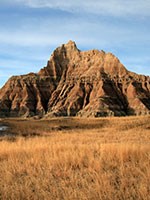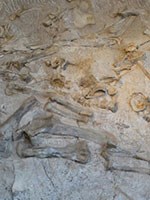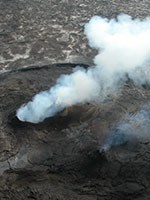Must See Geologic Sites
This list includes several must see geologic sites in our National Parks. These sites highlight America's rich geologic heritage and diversity. We hope you add these parks to your life list and visit them in the near future to enjoy everything they have to offer!

NPS Photo/Cathy Bell
Badlands National Park, South Dakota
Badlands contains some of the worlds most bizarre and "alien looking" landscapes; classic examples of badland topography. The poorly consolidated bedrock consisting of loose sediment and volcanic ash is quickly eroded by infrequent rainstorms. Resulting mud mounds, spires, and ridges resemble miniature mountain ranges.
[Geodiversity Atlas] [Park Home]

NPS Photo/Peter Jones
Carlsbad Caverns National Park, New Mexico
The Park contains more than 100 known caves, including the nation's deepest limestone cave at 1,604 feet and third longest. Carlsbad Cavern, with one of the world's largest underground chambers, displays an amazing array of cave and karst features. Rising sulphur-rich fluids mixed with fresh ground water to form sulphuric acid, which is responsible for the formation of this cave system.
[Geodiversity Atlas] [Park Home]

NPS Photo
Death Valley National Park, California and Nevada
Death Valley is world-famous for the incredible size, shape, and exposure of alluvial fans. One of the most stunning and archetypal is the Copper Canyon Fan, spreading out from the Black Mountains. The Black Mountain front is defined by a prominent fault scarp and the abrupt topographic transition from the mountains to the flat valley bottom creates ideal conditions for the formation of alluvial fans. In the deep channels cut into alluvial fans, the succession of fan deposits is easily observable; the darkest, most deeply desert varnished rocks are the oldest.
[Geodiversity Atlas] [Park Home]

Photo courtesy of Ken Redeker
Death Valley National Park, California and Nevada
Contains some of the best examples of playas and salt pans in North America. Playas, like "the racetrack" are shallow, transient lakes that form in closed basins and quickly evaporate whereas salt pans, like the ones at Badwater, are un-drained natural depressions where salt is deposited upon evaporation.
[Geodiversity Atlas] [Park Home]

NPS Photo/David Tarailo
Dinosaur National Monument, Utah and Colorado
Dinosaur National Monument is the archetypal dinosaur quarry and protects and displays classic fossil dinosaur bones including Allosaurus, Stegosaurus, Apatosaurus, and Archaeopteryx. The Quarry Wall in the visitor center houses over 1500 in situ bones, held in a river deposit within the world renowned Morrison Formation.
[Geodiversity Atlas] [Park Home]

NPS Photo/David Restivo.
Glacier National Park, Montana
The Lewis Overthrust is one of the world's largest and most famous thrust faults. A slice of Precambrian sedimentary rocks, over two kilometers thick and hundreds of kilometers wide, was thrust 80 kilometers eastward over softer Cretaceous rocks. Recent glaciations have exposed both layers and internal structures. In the eastern side of Glacier National Park, Chief Mountain provides a world class example of a klippe (an erosional remnant of a thrust sheet).
[Geodiversity Atlas] [Park Home]

NPS Photo/Michael Quinn
Grand Canyon National Park, Arizona
Hailed as one of the Seven Wonders of the World, the Grand Canyon exhibits the largest section of geologic time on earth. Hiking to the bottom, one passes through a third of the planet's age. The Park also contains excellent exposure of the world renowned Great Unconformity, an impressive angular unconformity, occupying 1.2 billion years in the rock record. The gap in the rock record straddles the Precambrian - Cambrian boundary and is found many places around the globe.
[Geodiversity Atlas] [Park Home]

NPS Photo
Grand Teton National Park, Wyoming
The Teton Fault is one of the most notable normal faults in North America. The east-dipping tensional fault shows over 10 kilometers of structural relief, with a calculated uplift rate of over one kilometer per million years. The Teton Mountains rise steeply out of the eastern plain, highlighting the effect of the fault.
[Geodiversity Atlas] [Park Home]

NPS photo/Dale Pate.
Hawaii Volcanoes National Park, Hawaii
Hawaii Volcanoes National Park contains the world's most massive mountain, Mauna Loa at 13,677 feet. Mauna Loa rises over 30,000 feet, when measured from its base on the seafloor, more than a thousand feet higher than Mount Everest. The park also contains Kilauea, the world's most active volcano. In contrast to explosive continental volcanoes, the more fluid and less gaseous eruptions of Kilauea and Mauna Loa produce awe inspiring, fiery fountains and rivers of molten lava that visitors can observe from a safe distance. Kilauea produces enough volcanic material every day to cover a football field to the height of the Washington Monument and has been erupting continuously since 1983.
[Geodiversity Atlas] [Park Home]

NPS Photo
Mammoth Cave National Park, Kentucky
Mammoth is the longest recorded cave system in the world with over 400 mapped miles. Mammoth preserves part of an archetypal karst landscape in South-Central Kentucky with sinkholes, vertical shafts, windows, and springs amongst other features.
[Geodiversity Atlas] [Park Home]

NPS Photo
Mount Rainier National Park, Washington
Has the largest collection of glaciers on one peak in the contiguous U.S. The mountain has 25 named glaciers and 50 smaller, unnamed glaciers and ice fields. In the Lower 48, Mount Rainier National Park has the thickest and most voluminous glacier, Carbon Glacier, and the glacier with the greatest surface area Emmons Glacier. It is one of the most accessible places to view glaciers up close.
[Geodiversity Atlas] [Park Home]

NPS Photo
Petrified Forest National Park, Arizona
Features one of the world's largest and most colorful collections of petrified wood. In the Triassic, trees were washed away in storms and floods and buried in an extensive floodplain under silt, mud, and volcanic ash. Ground water carrying dissolved silica from the volcanic ash crystallized around or replaced cell walls. Replacement was often so exact that even the most delicate details of the logs were preserved.
[Geodiversity Atlas] [Park Home]

NPS Photo/Neal Herbert
Yellowstone National Park, Wyoming, Montana, and Idaho
The Yellowstone Caldera is the largest in North America. The Yellowstone hotspot has actually produced three calderas in the Yellowstone region, the youngest of which is nearly 80 kilometers long and 50 kilometers wide. Up until 2 million years ago, there were caldera-forming eruptions roughly once every 600,000 years, future eruptions are expected.
[Geodiversity Atlas] [Park Home]

NPS Photo
Yellowstone National Park, Wyoming, Montana, and Idaho
Contains over half of the 1,000 or so known geysers in the world, including "Steamboat," the world's tallest geyser. Yellowstone National Park sits inside an ancient volcanic caldera with magma, in some places only a few miles underground, powering the park's famous geysers, hot springs, fumaroles, and mud pots. Super-heated water, trapped in underground channels, sends bubbles of steam upwards which eventually "lifts" the water and causes the geyser to overflow. The overflowing geyser releases enough pressure to allow the trapped water to violently boil and the resulting steam shoots the water dramatically out of the ground.
[Geodiversity Atlas] [Park Home]

Photo courtesy of Don Wood.
Yosemite National Park, California
Half-Dome is the classic and jaw-dropping example of an exfoliation dome. Located in perhaps the world's best example of a glacially carved canyon, Half-Dome's rounded appearance is due to sheet jointing (or exfoliation). The granitic pluton that formed the Sierra Nevada was slowly eroded, releasing pressure and causing the expansion of the underlying rock. Joints formed parallel to the earth's surface, which have since been exhumed and exposed. The sheer vertical face of Half-Dome, parallels regional joints and was carved out by glaciers.
[Geodiversity Atlas] [Park Home]
Explore more of America's geologic heritage
A Full Life | An Adventurous Life | An Extreme Life | Find Your Park
Last updated: July 8, 2024
